Greater Cleveland Aquarium
A visit in January 2012 shortly after its opening
On 21 January 2012 the Greater Cleveland Aquarium opened its doors, and for the first time since the City closed the old Cleveland Aquarium in the mid 80s, the people of North East Ohio had a public aquarium again. Naturally for any fish enthusiast this was an historic occasion, and my family just barely managed to keep me away on the opening weekend by pointing out the to-be-expected overcrowding. Accompanied by my Dad, I visited the Greater Cleveland Aquarium on Tuesday 24 January, just four days after the grand opening. The Greater Cleveland Aquarium is located in the historic FirstEnergy Powerhouse
Considering that we came in the middle of a regular weekday, I found the facility well visited but certainly not overcrowded. However, I have heard through the grapevine that the lines on the first weekend needed to be seen to be believed. We had bought our tickets online at GreaterClevelandAquarium.com, and walked right in. Buying tickets in advance might be a good idea allowing you to jump the queue if you want to visit in the weekend, but probably won't be necessary if you come during the week.
The Greater Cleveland Aquarium is located in the historic FirstEnergy Powerhouse, which is both, a burden and an asset. A disadvantage are the space constraints that an historic building imposes. They manifest themselves in a current ban on strollers, which makes the facility less than family friendly for those with very small kids. This is said to be a temporary policy. Considering the number of visitors I saw, I would expect it to be lifted shortly, at least during the week, but for now the policy is in place.
The historic building becomes a bonus when it comes to providing a grand setting for the aquarium, as seen in the photo below that shows the entrance hall.
The Greater Cleveland Aquarium is located in the historic FirstEnergy Powerhouse
Considering that we came in the middle of a regular weekday, I found the facility well visited but certainly not overcrowded. However, I have heard through the grapevine that the lines on the first weekend needed to be seen to be believed. We had bought our tickets online at GreaterClevelandAquarium.com, and walked right in. Buying tickets in advance might be a good idea allowing you to jump the queue if you want to visit in the weekend, but probably won't be necessary if you come during the week.
The Greater Cleveland Aquarium is located in the historic FirstEnergy Powerhouse, which is both, a burden and an asset. A disadvantage are the space constraints that an historic building imposes. They manifest themselves in a current ban on strollers, which makes the facility less than family friendly for those with very small kids. This is said to be a temporary policy. Considering the number of visitors I saw, I would expect it to be lifted shortly, at least during the week, but for now the policy is in place.
The historic building becomes a bonus when it comes to providing a grand setting for the aquarium, as seen in the photo below that shows the entrance hall.
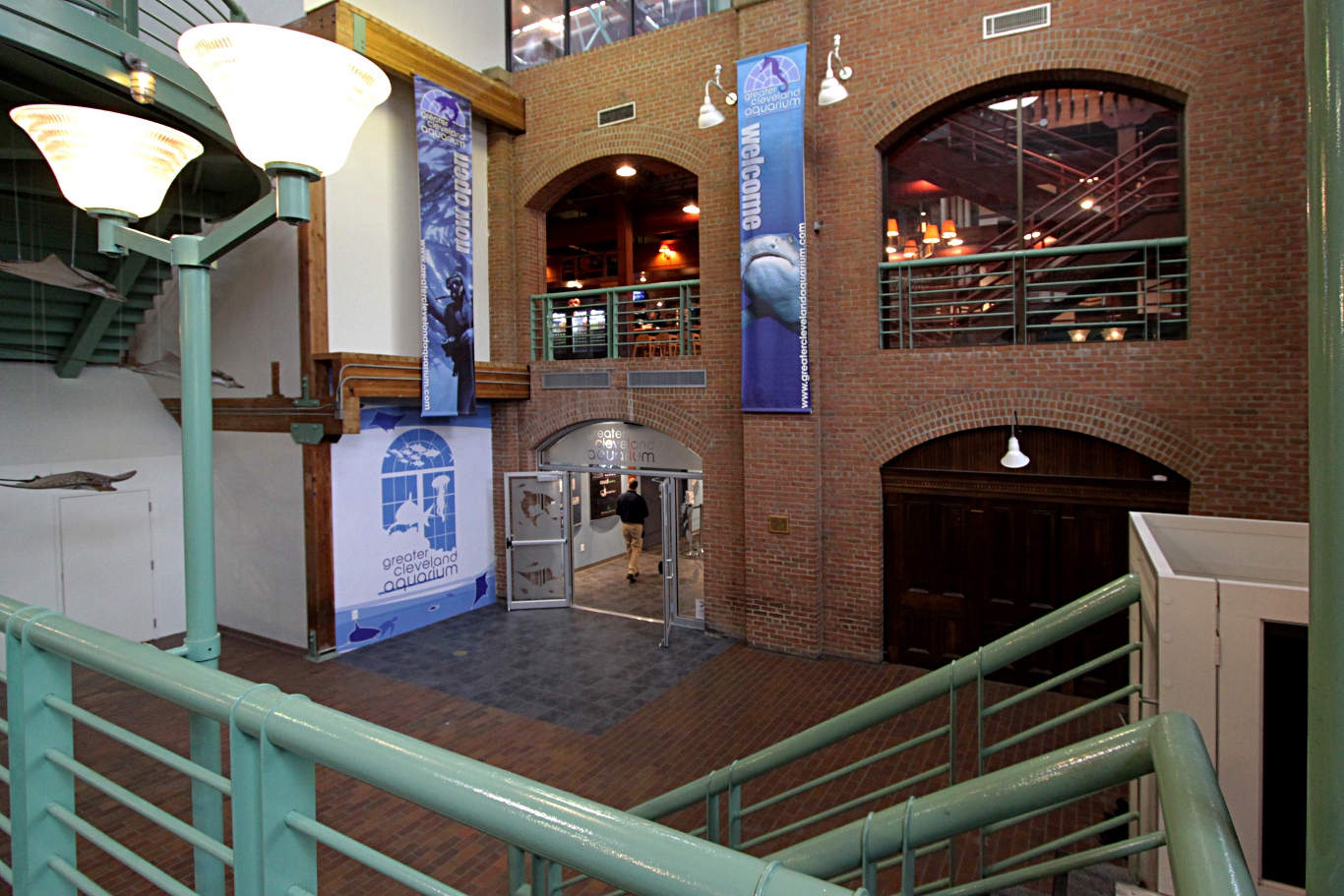 Entrance Hall of the historic FirstEnergy Powerhouse with entry to the Greater Cleveland Aquarium
The building also provides many opportunities for integrating fish tanks into its unique features, and makes for very attractive back-drops for the tanks. The designers of the Greater Cleveland Aquarium have taken advantage of that to the fullest. The tanks look stunning in front of lots of exposed brickwork, and the stands built from comparatively rough wood blend right in.
Entrance Hall of the historic FirstEnergy Powerhouse with entry to the Greater Cleveland Aquarium
The building also provides many opportunities for integrating fish tanks into its unique features, and makes for very attractive back-drops for the tanks. The designers of the Greater Cleveland Aquarium have taken advantage of that to the fullest. The tanks look stunning in front of lots of exposed brickwork, and the stands built from comparatively rough wood blend right in.
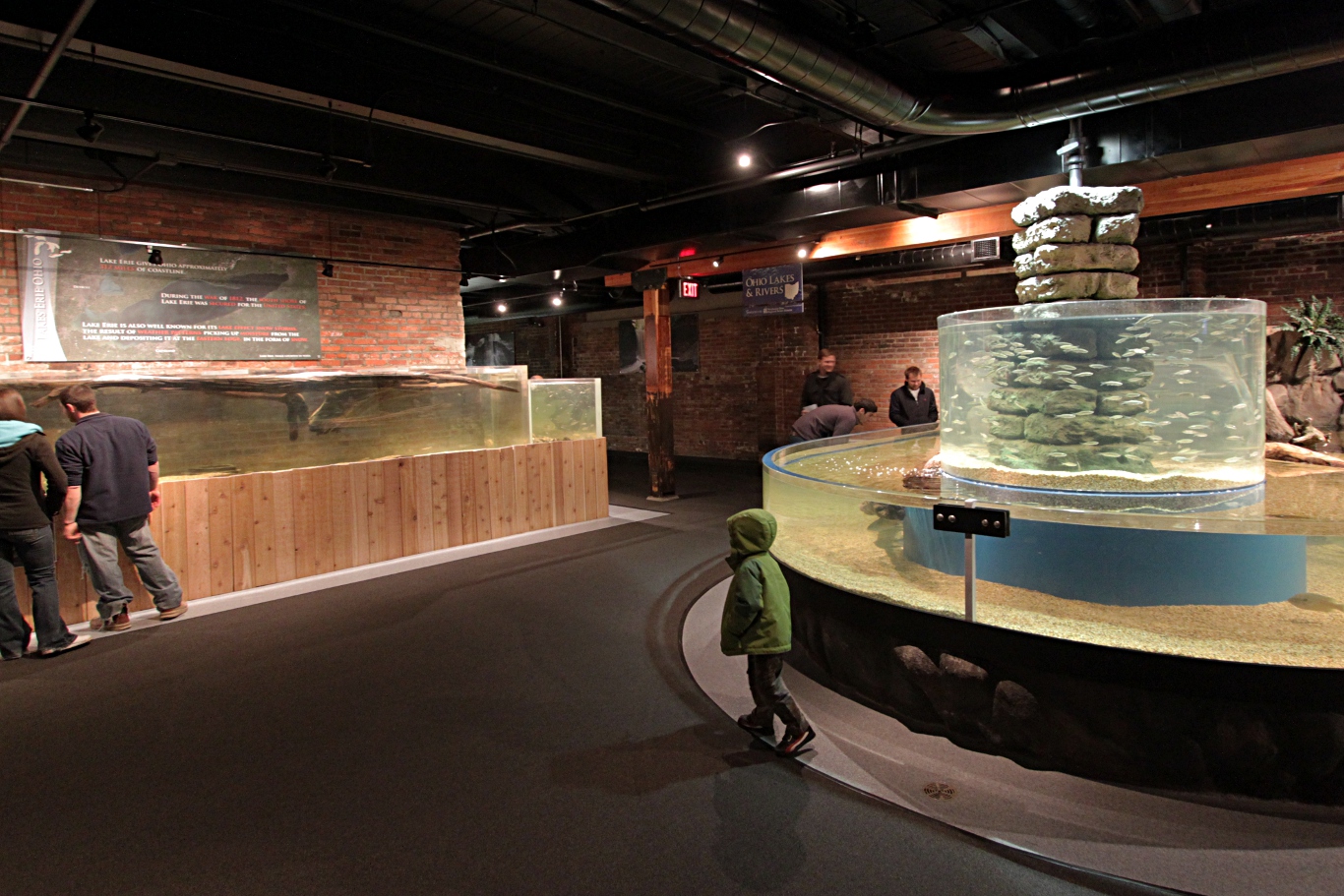 Some of the tanks housing fish that are native to North East Ohio
The first feature greeting the visitor is an extensive collection of fish that are native to North East Ohio. Most tanks are long and narrow to simulate a river environment, but the flow of water through the tanks appears fairly low. I have very limited experience keeping native Ohio fish species in captivity, but I believe they require fast flowing, oxygen rich water, that is fairly cold even in summer. The fish showed no signs of undue stress, but I wonder if the flow through these tanks will be able to provide sufficient aeration, especially in summer. The historic building with its thick brick walls should at least help in keeping the temperatures down. At the time of my visit, some of the tanks looked a little unfinished because wood that was presumably meant to sit on the bottom was still floating, but I guess this will sort itself out in due course. Overall, I found the the native fish section fascinating and a great asset to the Aquarium.
Some of the tanks housing fish that are native to North East Ohio
The first feature greeting the visitor is an extensive collection of fish that are native to North East Ohio. Most tanks are long and narrow to simulate a river environment, but the flow of water through the tanks appears fairly low. I have very limited experience keeping native Ohio fish species in captivity, but I believe they require fast flowing, oxygen rich water, that is fairly cold even in summer. The fish showed no signs of undue stress, but I wonder if the flow through these tanks will be able to provide sufficient aeration, especially in summer. The historic building with its thick brick walls should at least help in keeping the temperatures down. At the time of my visit, some of the tanks looked a little unfinished because wood that was presumably meant to sit on the bottom was still floating, but I guess this will sort itself out in due course. Overall, I found the the native fish section fascinating and a great asset to the Aquarium.
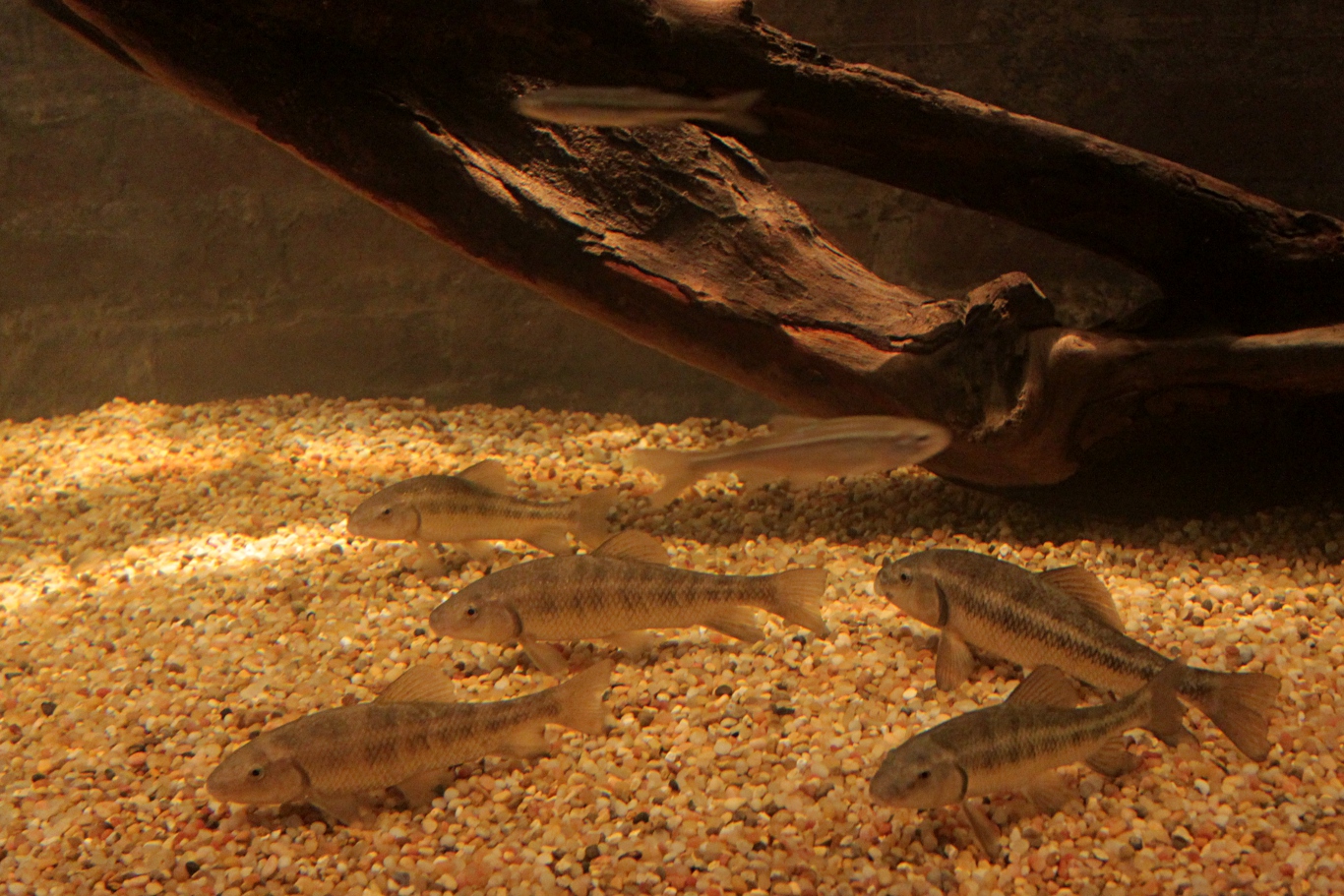 Native Ohio fish – those more interested in fishing than myself will have no trouble identifying them
Native Ohio fish – those more interested in fishing than myself will have no trouble identifying them
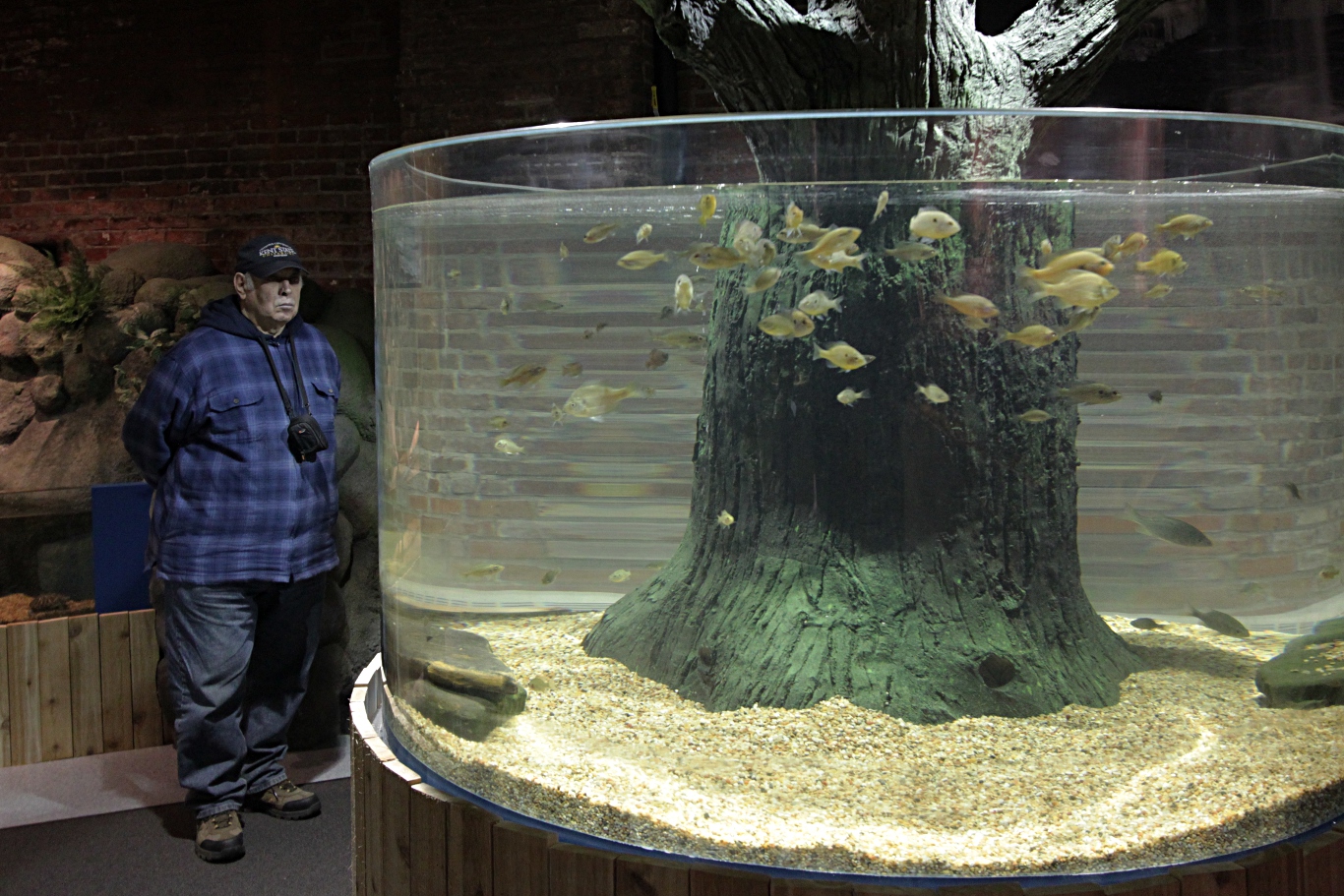 Some more native Ohio fish
Many of the tanks in the Greater Cleveland Aquarium have a circular footprint. This immediately distinguishes them from the tanks most any fish enthusiast might have at home. It also allows viewing from all sides, and by picking up the theme of the smoke stacks and the arched ceilings of the historic powerhouse in which the aquarium is situated, circular tanks fit in well with the architecture. These tanks encourage the continuous movement typically observed with swarm-forming fish. However, they provide little to no cover for fish that occasionally like to hide. Also, staking out territories becomes very difficult for fish like cichlids that are naturally territorial. Unfortunately in the Greater Cleveland Aquarium, circular tanks are stocked with fish regardless of their natural behavior and associated requirements. Last but not least, the curved acrylic distorts the view of the fish. Note how the fake tree trunk in the above photo appears to be much thinner outside of the tank than inside the tank.
After the large and interesting native fish section, the visitor passes an educational display about invasive species, which curiously is stocked with fancy goldfish. Next to it is a tank with an assortment of common tropical aquarium fish, including for example various tetras, corydoras species, and Blue Rams cichlids. The next room is shown in the photo below. Outside of the frame to the right is a large display featuring alligators. The large tank in the foreground on the left contains an odd assortment of fish ranging from various rays to what could be a collection of fish-store-rescues – tank busting South and Central American cichlids. I initially thought the tank had a New World theme, but I eventually discovered some Asian inhabitants as well - a giant gourami (Osphronemus goramy) , and a red tail shark (Epalzeorhynchos bicolor). In the background you can see three circular tanks, which supposedly contain (from left to right), Amazon river, Lake Malawi, and Lake Tanganyika biotopes.
Some more native Ohio fish
Many of the tanks in the Greater Cleveland Aquarium have a circular footprint. This immediately distinguishes them from the tanks most any fish enthusiast might have at home. It also allows viewing from all sides, and by picking up the theme of the smoke stacks and the arched ceilings of the historic powerhouse in which the aquarium is situated, circular tanks fit in well with the architecture. These tanks encourage the continuous movement typically observed with swarm-forming fish. However, they provide little to no cover for fish that occasionally like to hide. Also, staking out territories becomes very difficult for fish like cichlids that are naturally territorial. Unfortunately in the Greater Cleveland Aquarium, circular tanks are stocked with fish regardless of their natural behavior and associated requirements. Last but not least, the curved acrylic distorts the view of the fish. Note how the fake tree trunk in the above photo appears to be much thinner outside of the tank than inside the tank.
After the large and interesting native fish section, the visitor passes an educational display about invasive species, which curiously is stocked with fancy goldfish. Next to it is a tank with an assortment of common tropical aquarium fish, including for example various tetras, corydoras species, and Blue Rams cichlids. The next room is shown in the photo below. Outside of the frame to the right is a large display featuring alligators. The large tank in the foreground on the left contains an odd assortment of fish ranging from various rays to what could be a collection of fish-store-rescues – tank busting South and Central American cichlids. I initially thought the tank had a New World theme, but I eventually discovered some Asian inhabitants as well - a giant gourami (Osphronemus goramy) , and a red tail shark (Epalzeorhynchos bicolor). In the background you can see three circular tanks, which supposedly contain (from left to right), Amazon river, Lake Malawi, and Lake Tanganyika biotopes.
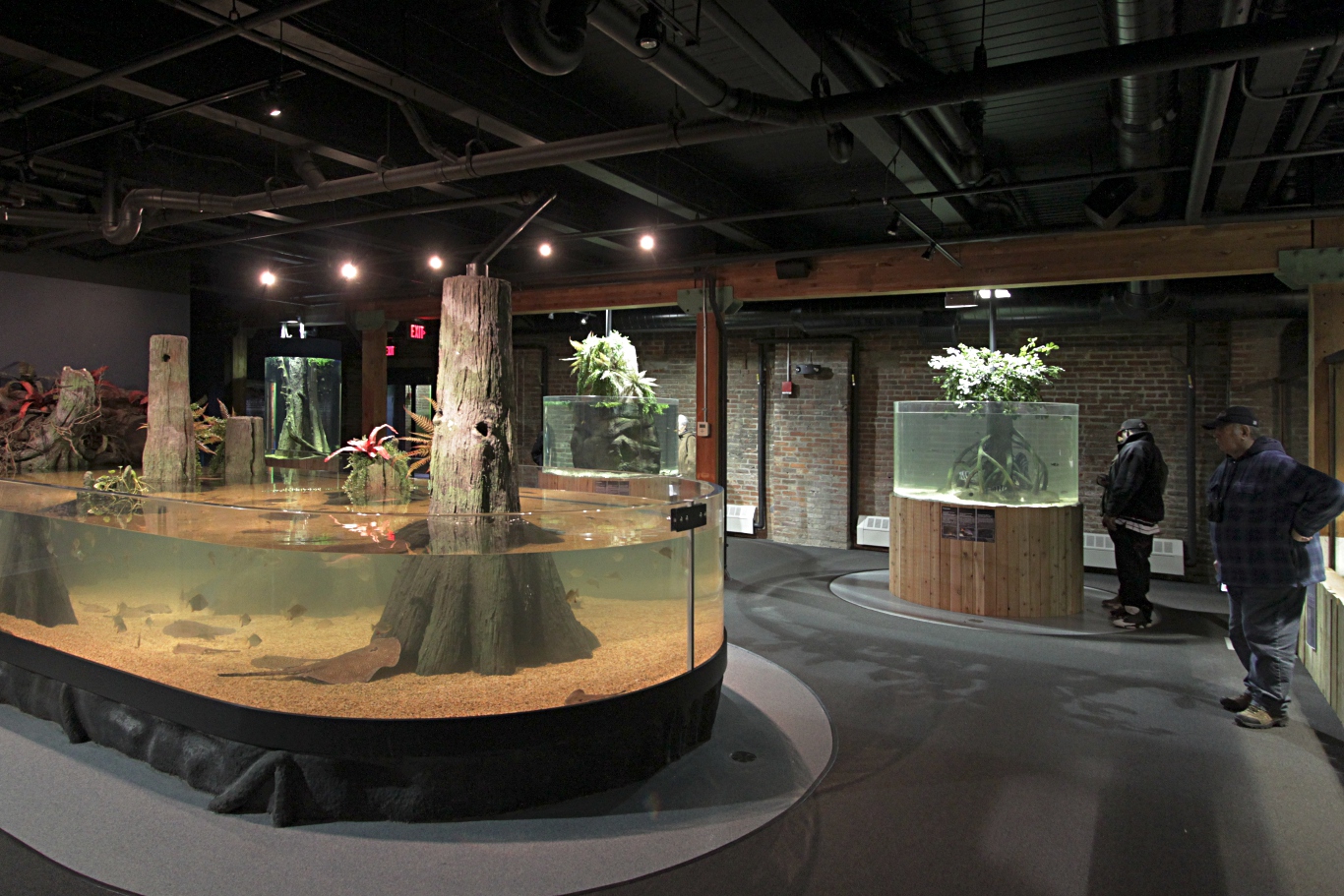 Room with various warm freshwater setups
I am not much of a New World enthusiast myself, so I only gave the Amazon setup a quick glance. To me it appeared pretty decent with a group of angelfish as centerpiece, but also some mesonauta, plecos, and so on. The Lake Malawi setup looked like somebody's grow-out tank with lots of juvenile fish, consisting of an assortment of mbuna, haps and peacocks, thrown together without giving it much thought. When those fish grow up, I would expect the tank to become a kind of Woodstock meets World War 3 – free love between all at the same time as unlimited warfare.
As a huge Tanganyika fan, my pet peeve in the whole Aquarium is the Tanganyika tank that is a perfect example of how not to do it. As previously pointed out, a circular tank does not lend itself to provide suitable conditions for territorial fish, which most Tanganyikans are. Also, the fake tree trunk provided as decoration is completely wrong for the Tanganyikan habitat that's dominated by rocks. According to the labels on the tank, the main inhabitants were supposed to be Paracyprichromis nigripinnis, Cyprichromis leptosoma 'Utinta' and Tropheus duboisi, which would have been a pretty good stocking list for the tank, and might have actually benefited from the circular shape. However, in reality the centerpiece of the tank was a colony of adult Frontosa – presumably of the Burundi variety. Admittedly, they were big and awesome looking. I'd say the biggest Frontosa I have seen so far, but then the curved glass of the tank makes the size of fish impossible to judge. Of the cyps and paracyps there was no trace to be seen, other than that the frontosa looked exceedingly well fed. I'd hazard a guess that there was a causal relationship. The tropheus looked little frazzled, and were not as active as I'd expect tropheus to be. As any experienced aquarist will be able to confirm, different temperaments and different feeding requirements make frontosa and tropheus notoriously bad tank mates. Often the hyperactive tropheus will stress out the docile frontosa, but here it seemed that the adult frontosa had the upper hand over tropheus that might have been weakened already by digestive problems caused by protein-rich food suitable and necessary for frontosa but not tropheus. In addition to the aforementioned fish, the tank also contained various small juvenile lamprologine, including altolamprologus and shelldwellers – all of them potential food for the huge frontosa. It would be unfair to judge the entire Aquarium by the small Tanganyika display, but I cannot help but say that it would have been better not to have a Tanganyika biotope than this one.
Room with various warm freshwater setups
I am not much of a New World enthusiast myself, so I only gave the Amazon setup a quick glance. To me it appeared pretty decent with a group of angelfish as centerpiece, but also some mesonauta, plecos, and so on. The Lake Malawi setup looked like somebody's grow-out tank with lots of juvenile fish, consisting of an assortment of mbuna, haps and peacocks, thrown together without giving it much thought. When those fish grow up, I would expect the tank to become a kind of Woodstock meets World War 3 – free love between all at the same time as unlimited warfare.
As a huge Tanganyika fan, my pet peeve in the whole Aquarium is the Tanganyika tank that is a perfect example of how not to do it. As previously pointed out, a circular tank does not lend itself to provide suitable conditions for territorial fish, which most Tanganyikans are. Also, the fake tree trunk provided as decoration is completely wrong for the Tanganyikan habitat that's dominated by rocks. According to the labels on the tank, the main inhabitants were supposed to be Paracyprichromis nigripinnis, Cyprichromis leptosoma 'Utinta' and Tropheus duboisi, which would have been a pretty good stocking list for the tank, and might have actually benefited from the circular shape. However, in reality the centerpiece of the tank was a colony of adult Frontosa – presumably of the Burundi variety. Admittedly, they were big and awesome looking. I'd say the biggest Frontosa I have seen so far, but then the curved glass of the tank makes the size of fish impossible to judge. Of the cyps and paracyps there was no trace to be seen, other than that the frontosa looked exceedingly well fed. I'd hazard a guess that there was a causal relationship. The tropheus looked little frazzled, and were not as active as I'd expect tropheus to be. As any experienced aquarist will be able to confirm, different temperaments and different feeding requirements make frontosa and tropheus notoriously bad tank mates. Often the hyperactive tropheus will stress out the docile frontosa, but here it seemed that the adult frontosa had the upper hand over tropheus that might have been weakened already by digestive problems caused by protein-rich food suitable and necessary for frontosa but not tropheus. In addition to the aforementioned fish, the tank also contained various small juvenile lamprologine, including altolamprologus and shelldwellers – all of them potential food for the huge frontosa. It would be unfair to judge the entire Aquarium by the small Tanganyika display, but I cannot help but say that it would have been better not to have a Tanganyika biotope than this one.
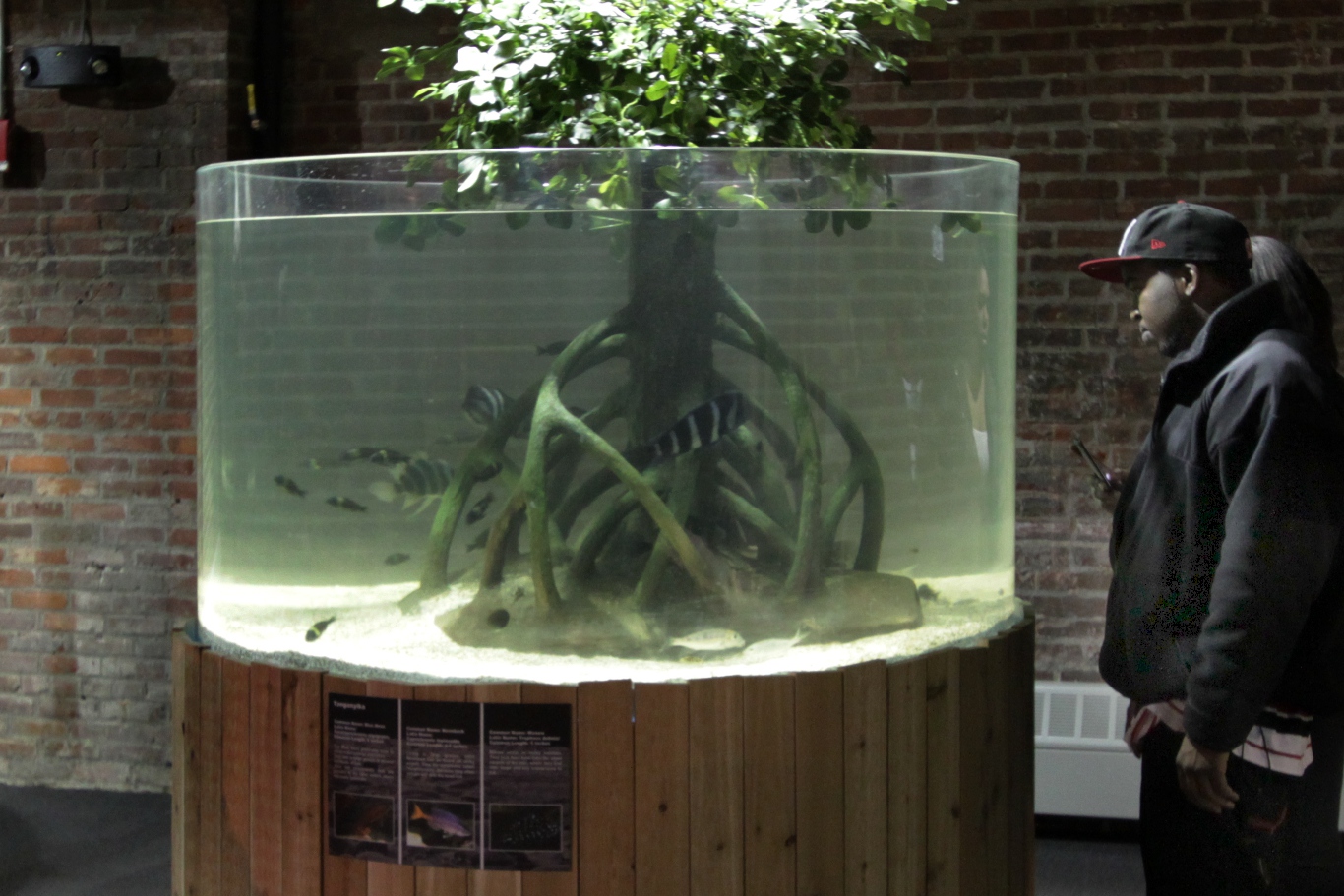 Lake Tanganyika display
The room contained three information posters, one about the Amazon River, one about Lake Malawi, and one about the Mekong Delta. How these were supposed to match up with the displays remained mysterious to me.
Another noteworthy detail might be that absolutely no life plants were used in any of the freshwater setups of the Aquarium. Let's hope this is planned for the future, since they would make a worthwhile addition.
Following this room was a hallway that showed yet again the designers' ingenious integration of the Aquarium into the historic building. First came a circular skylight offering views up the outside of the chimney of the powerhouse, highlighting it's impressive height. With the visitors attention drawn upward, there came a lobster tank integrated in the ceiling offering intriguing views of the crustaceans from underneath.
Lake Tanganyika display
The room contained three information posters, one about the Amazon River, one about Lake Malawi, and one about the Mekong Delta. How these were supposed to match up with the displays remained mysterious to me.
Another noteworthy detail might be that absolutely no life plants were used in any of the freshwater setups of the Aquarium. Let's hope this is planned for the future, since they would make a worthwhile addition.
Following this room was a hallway that showed yet again the designers' ingenious integration of the Aquarium into the historic building. First came a circular skylight offering views up the outside of the chimney of the powerhouse, highlighting it's impressive height. With the visitors attention drawn upward, there came a lobster tank integrated in the ceiling offering intriguing views of the crustaceans from underneath.
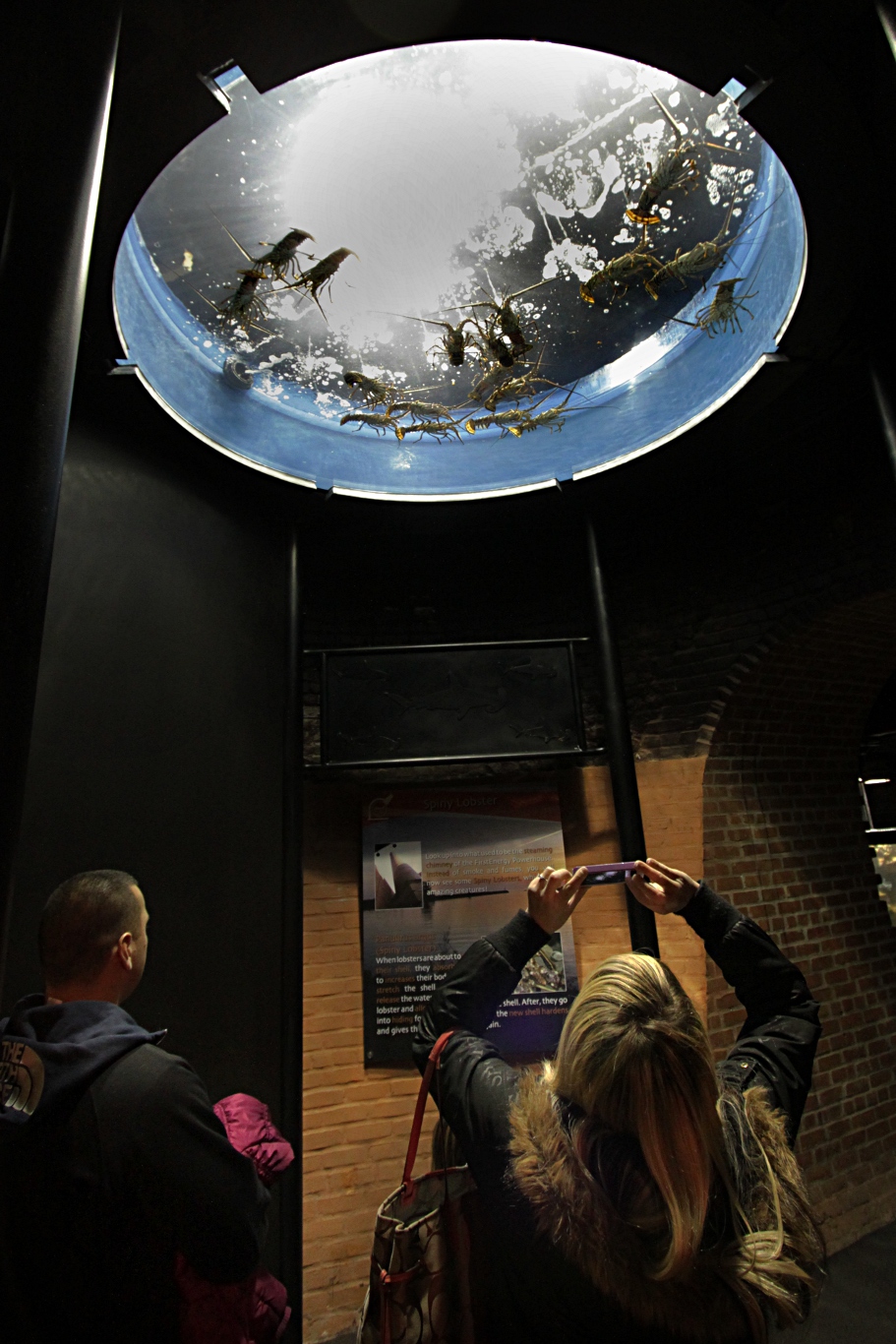 Lobster tank in the ceiling
Lobster tank in the ceiling
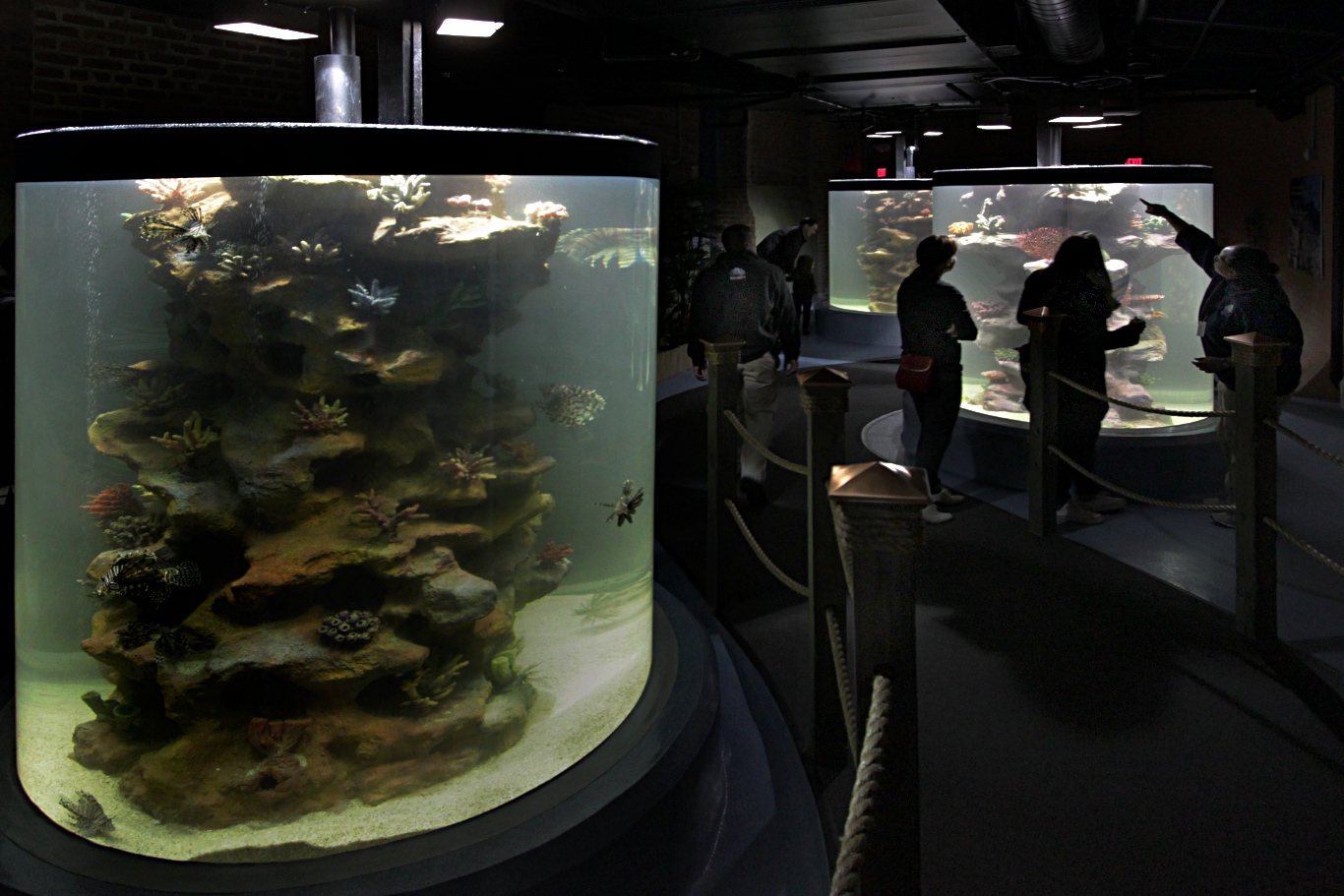 Some marine setups
The next room contained three circular tanks with marine fish (see photo above). Centerpiece of the first tank was a very large number of lion-fish (Pterois sp.), and the second one housed some fairly secretive octopuses.
The next hallway continued with various marine displays. I remember seeing seahorses, but since I know little about marine fish, I couldn't list species here. The tanks were built into what looked like old door niches – again an excellent use of the architectural features of the site. The tanks were as wide as a door and also as high – an estimated five feet - but only maybe a foot deep into the wall. I hope the operators know how anybody is ever going to do maintenance at the bottom of these tanks, because I don't.
Conspicuous by their absence were life corals and other creatures typical for reef setups. I'd guess that it would be hard to supply them with the necessary light in the very deep tanks of the aquarium, but I am sure marine enthusiasts will find all those fish-only setups with Disney look-alike fake corals, sponges, and so on a little lacking.
Some marine setups
The next room contained three circular tanks with marine fish (see photo above). Centerpiece of the first tank was a very large number of lion-fish (Pterois sp.), and the second one housed some fairly secretive octopuses.
The next hallway continued with various marine displays. I remember seeing seahorses, but since I know little about marine fish, I couldn't list species here. The tanks were built into what looked like old door niches – again an excellent use of the architectural features of the site. The tanks were as wide as a door and also as high – an estimated five feet - but only maybe a foot deep into the wall. I hope the operators know how anybody is ever going to do maintenance at the bottom of these tanks, because I don't.
Conspicuous by their absence were life corals and other creatures typical for reef setups. I'd guess that it would be hard to supply them with the necessary light in the very deep tanks of the aquarium, but I am sure marine enthusiasts will find all those fish-only setups with Disney look-alike fake corals, sponges, and so on a little lacking.
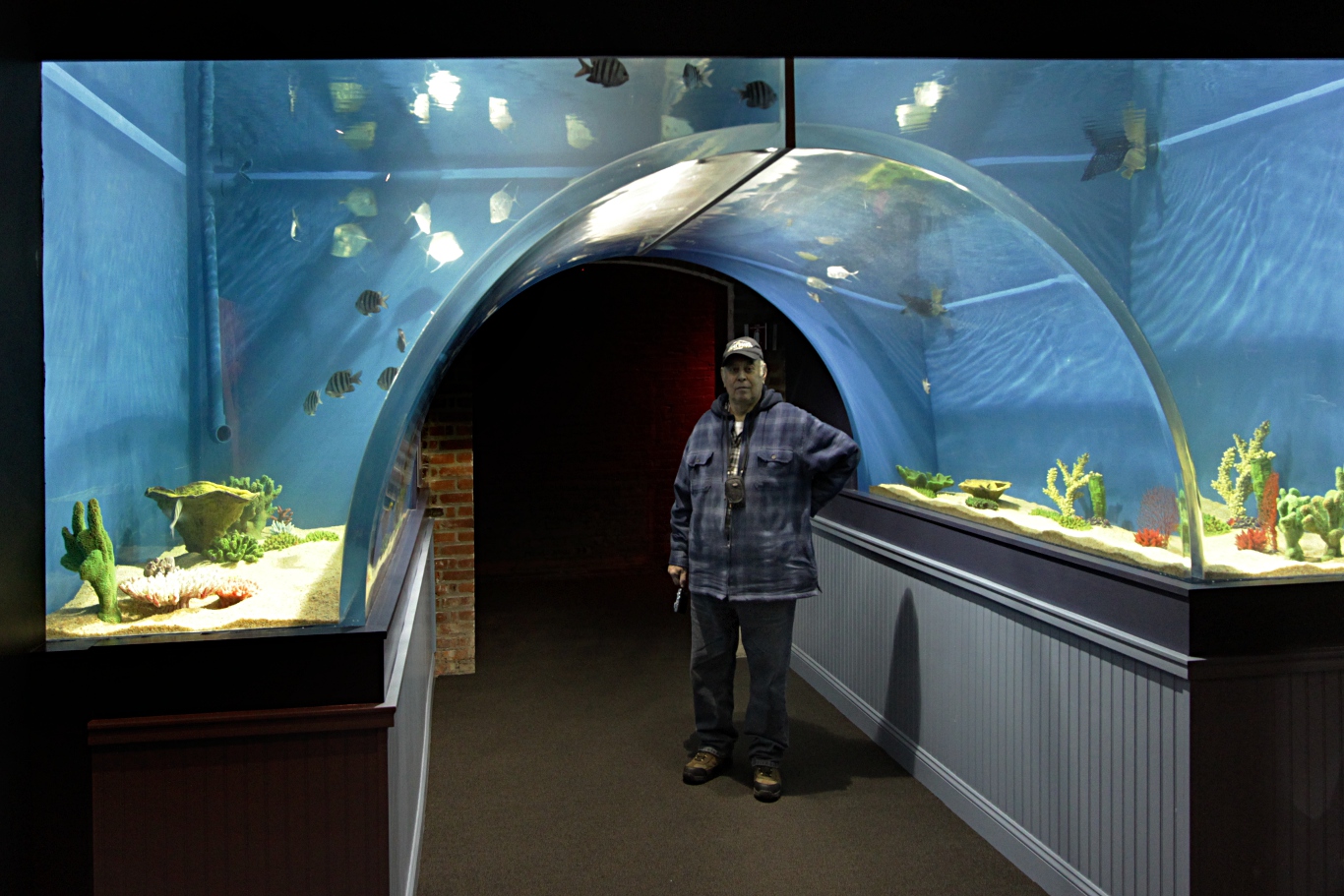 Tunnel shaped marine tank
Through a tunnel shaped marine tank the visitor entered a large hall containing the Touch Pool of the Aquarium. During my visit two employees in wet suits were stationed in the tank to interact with visitors, show them the tank inhabitants and let people pet suitable creatures if desired. That pool is sure to be a highlight with the kids, but interesting for adults nevertheless.
In addition to the employees in wet suits, the whole aquarium was swarming with staff. The level of service surpassed any expectation, but I wonder if it will be possible for the Aquarium to generate the income that allows it to sustain these high standards in the long term.
Tunnel shaped marine tank
Through a tunnel shaped marine tank the visitor entered a large hall containing the Touch Pool of the Aquarium. During my visit two employees in wet suits were stationed in the tank to interact with visitors, show them the tank inhabitants and let people pet suitable creatures if desired. That pool is sure to be a highlight with the kids, but interesting for adults nevertheless.
In addition to the employees in wet suits, the whole aquarium was swarming with staff. The level of service surpassed any expectation, but I wonder if it will be possible for the Aquarium to generate the income that allows it to sustain these high standards in the long term.
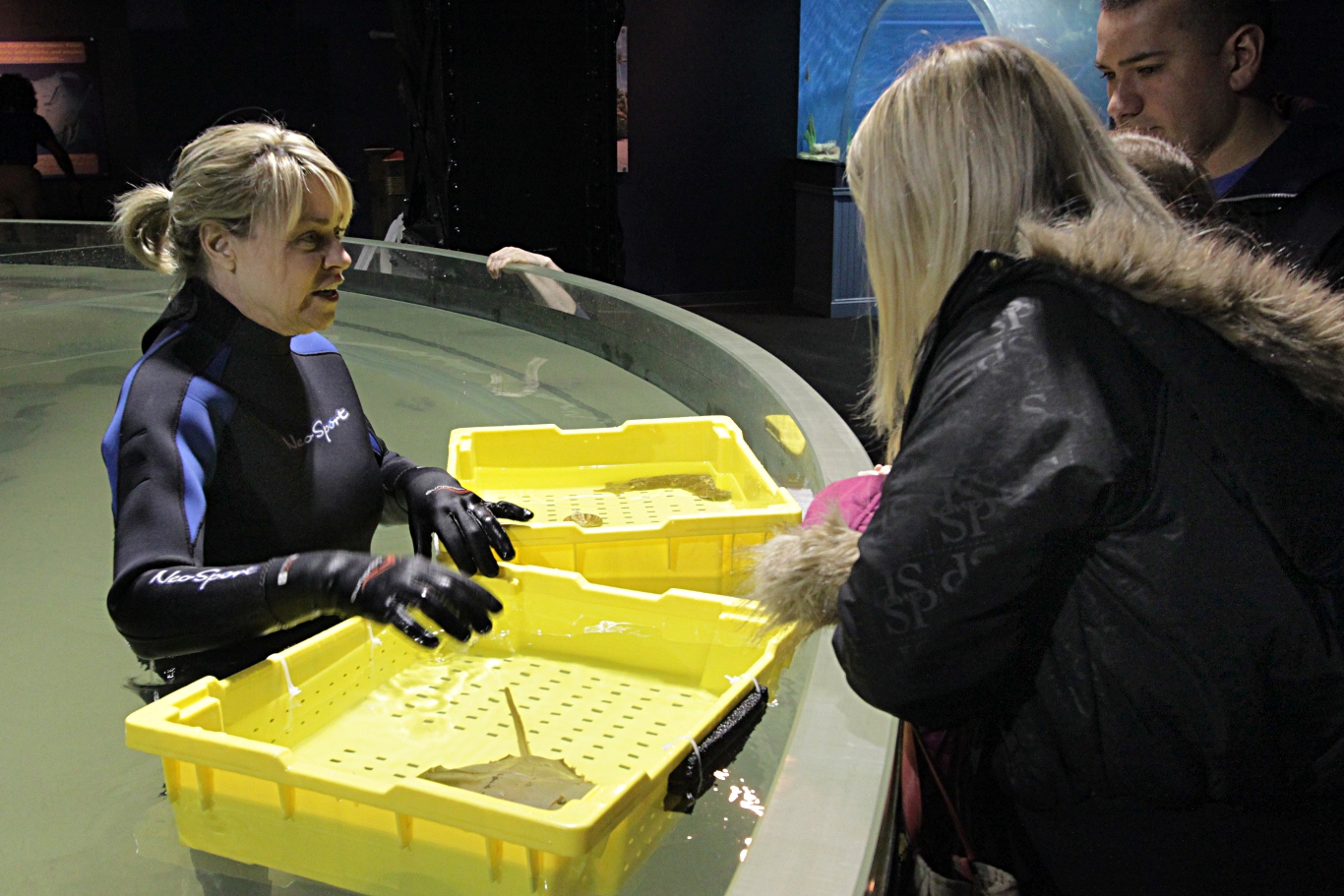 Touch Pool
The crowning highlight of the Aquarium experience in Cleveland, to which the whole visit leads up, is the large shark tank. Unfortunately during my visit the water was so cloudy that most viewing windows only allowed a few feet sight into the tank, and nearly all of the inhabitants remained invisible.
Touch Pool
The crowning highlight of the Aquarium experience in Cleveland, to which the whole visit leads up, is the large shark tank. Unfortunately during my visit the water was so cloudy that most viewing windows only allowed a few feet sight into the tank, and nearly all of the inhabitants remained invisible.
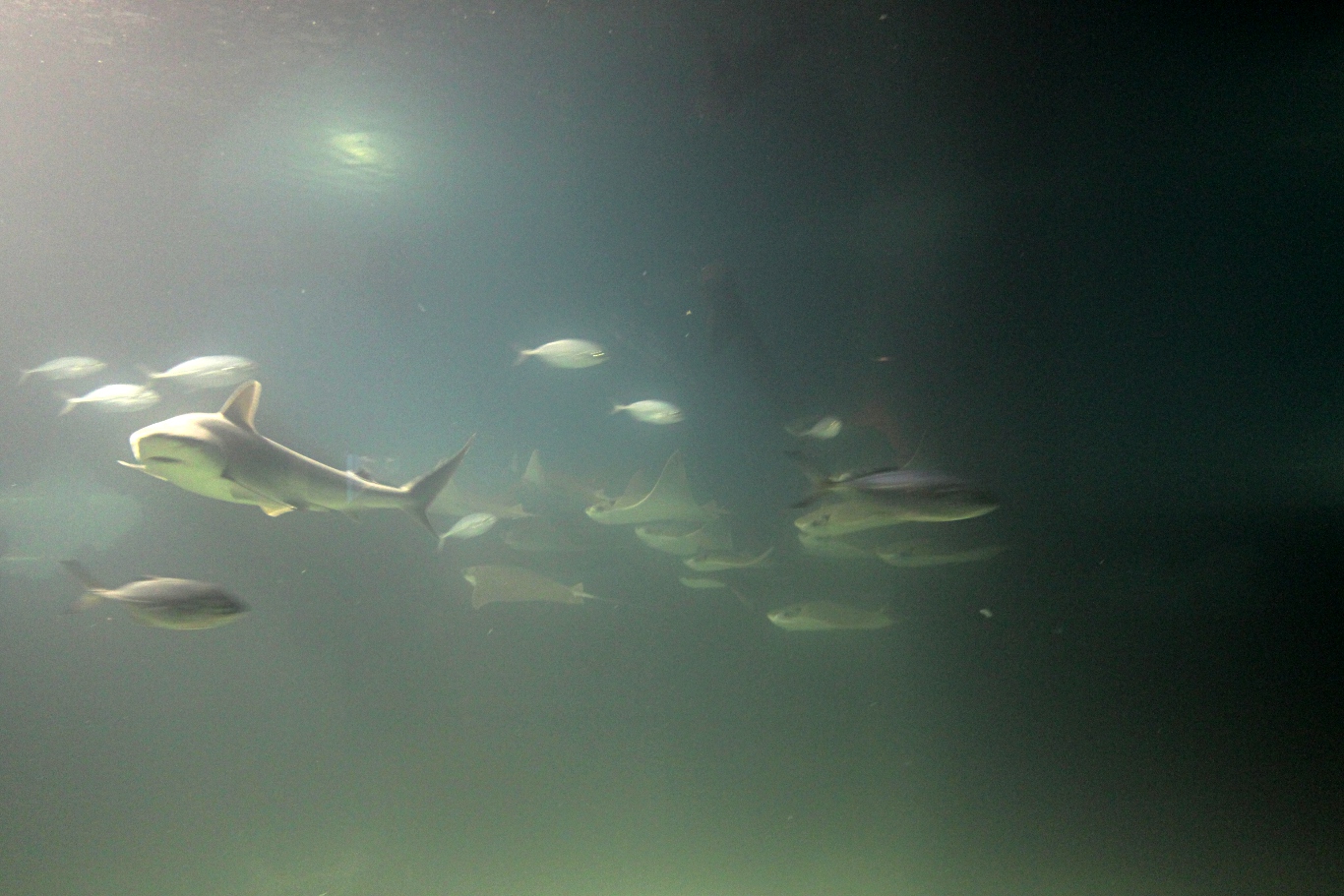 Shark tank
The photo below shows one viewing window were backlight from the SeaTube® tunnel (visible in the background), allowed me to capture an image of some of the impressive sharks. The SeaTube® allows visitors to virtually walk through the tank, being surrounded by sharks and other sea creatures, but when I visited visibility was so poor that nothing but the fake ship wreck could be seen.
Shark tank
The photo below shows one viewing window were backlight from the SeaTube® tunnel (visible in the background), allowed me to capture an image of some of the impressive sharks. The SeaTube® allows visitors to virtually walk through the tank, being surrounded by sharks and other sea creatures, but when I visited visibility was so poor that nothing but the fake ship wreck could be seen.
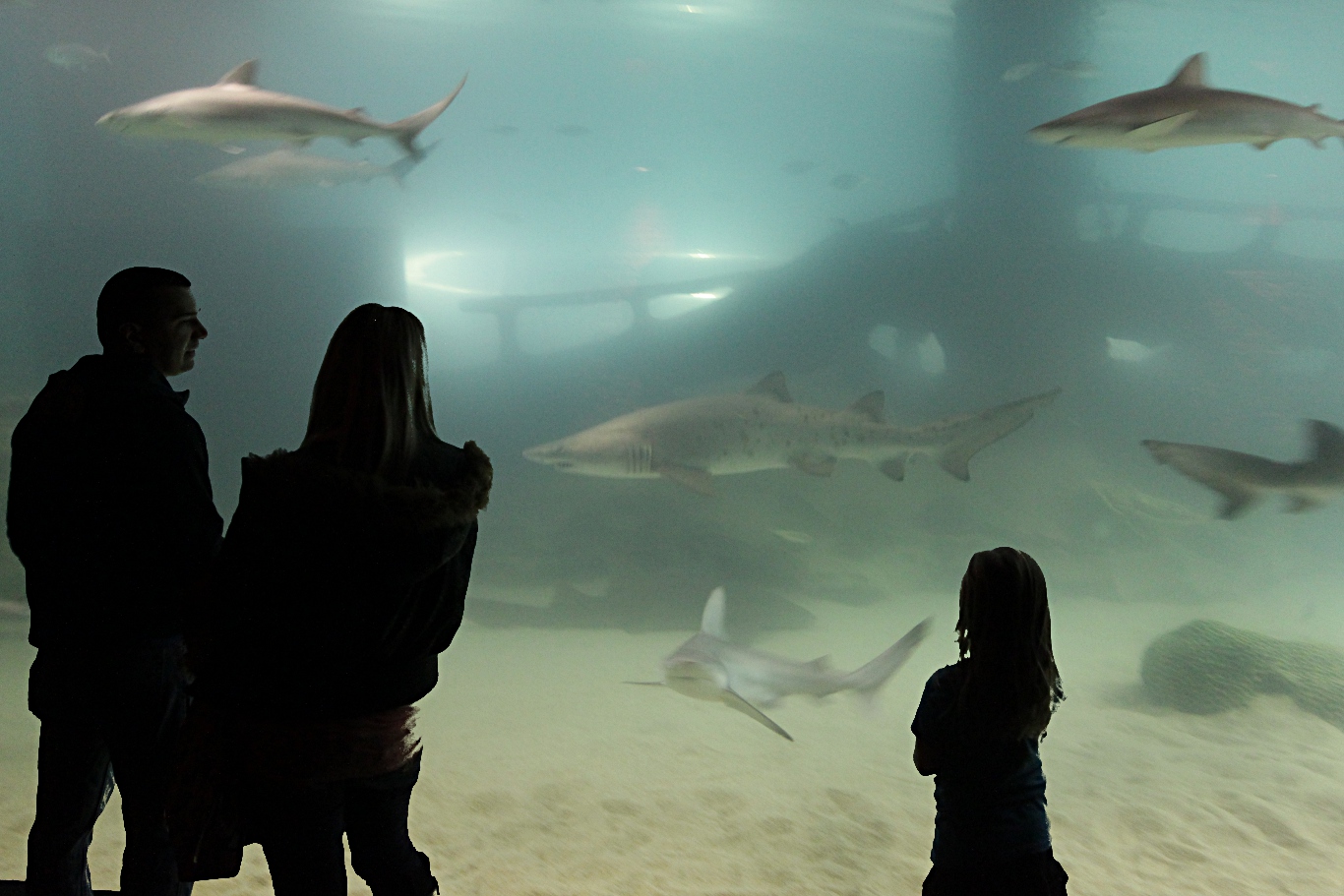 Shark tank with SeaTube®
In most other tanks of the Greater Cleveland Aquarium water clarity left a little to be desired, but the issue could largely be ignored until I came to the shark tank. There even seemed to be a slimy layer on the water surface as far as I could make out looking through the viewing windows below. Especially if you are planning to visit with kids, I would recommend to wait until the cloudy water situation has been resolved. Maybe give the aquarium a call and check. I am sure these are just teething troubles, but most kids might feel severely deprived if they encountered the shark tank in this shape.
Another positive point was that parking was conveniently available in front of the door. However at an extra cost of $3. At $21.95 for an adult ticket it would be nice to have that included in the price. As it is, for just two adults you need to budget almost $50 for a visit. That's a lot of money for about 1.5 hours entertainment, and kids from 2-12 years are $15.95 per head extra.
What I liked best about the Greater Cleveland Aquarium:
Shark tank with SeaTube®
In most other tanks of the Greater Cleveland Aquarium water clarity left a little to be desired, but the issue could largely be ignored until I came to the shark tank. There even seemed to be a slimy layer on the water surface as far as I could make out looking through the viewing windows below. Especially if you are planning to visit with kids, I would recommend to wait until the cloudy water situation has been resolved. Maybe give the aquarium a call and check. I am sure these are just teething troubles, but most kids might feel severely deprived if they encountered the shark tank in this shape.
Another positive point was that parking was conveniently available in front of the door. However at an extra cost of $3. At $21.95 for an adult ticket it would be nice to have that included in the price. As it is, for just two adults you need to budget almost $50 for a visit. That's a lot of money for about 1.5 hours entertainment, and kids from 2-12 years are $15.95 per head extra.
What I liked best about the Greater Cleveland Aquarium:
- Integration of Aquarium into the historic building,
- Large section with native Ohio fish displays,
- Great touch pool,
- Impressive Shark tank with SeaTube® (once it's cleared up).
- Aeration seems lacking in many tanks (might even be the problem in shark tank?)
- Half-heartedly done warm freshwater setups
- No plants and life corals.
This article is ©Frank Mueller 2012, and was published in the February 2012 Bulletin of the Ohio Cichid Association. A PDF version of the article, for example for downloading and printing, is here.
Leave a Reply
You must be logged in to post a comment.
